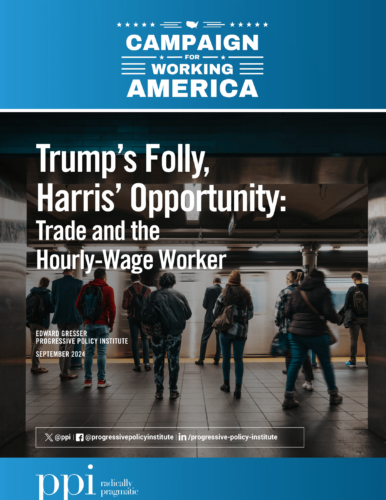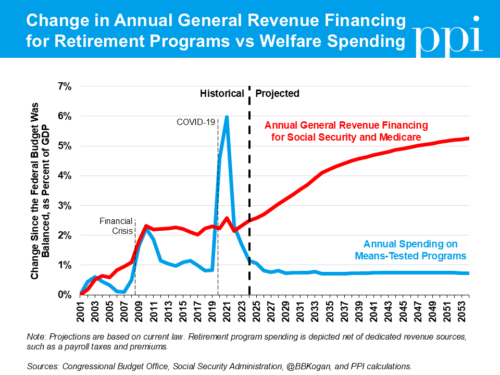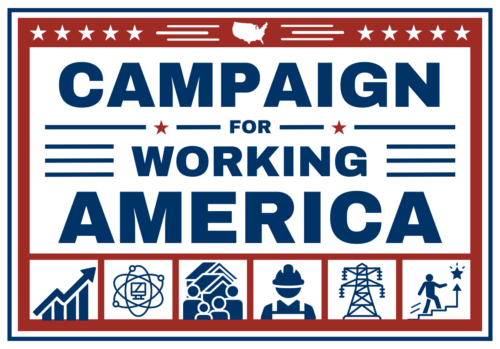FACT: “Sometimes countries make big and fateful choices … and sometimes their big and fateful choices go badly wrong.”
THE NUMBERS: U.S. hourly-wage and comparable workers, 2023* –
| Total Employed: |
161.0 million |
| Hourly wages or equivalent |
80.5 million |
| “Industrial” hourly-wage workers** |
15.7 million |
| “Non-industrial” hourly-wage workers |
64.8 million |
* Bureau of Labor Statistics, full-year averages
** “Industrial” includes 8.9 million manufacturing workers, 5.7 million in construction, 0.3 million in energy and mining, and 0.8 million in agriculture. Top “non-industrial” categories include 12.5 million workers in health and social assistance, 10.9 million in retail, and 7.3 million in restaurants and other food service jobs.
WHAT THEY MEAN:
PPI’s newest report, Trump’s Folly, Harris’ Opportunity: Trade and the Blue-Collar Worker, opens with a warning:
“Sometimes countries make big and fateful choices. … And sometimes big and fateful choices go badly wrong. American isolationism in the 1920s and 1930s helped make World War II possible. The ‘America First Committee’ policies*, had the U.S. adopted them in 1940, might have caused its loss. Hoover’s 1930 tariff hikes, advertised as a way to keep U.S. wages high and jobs at home, provoked retaliations and a deepened economic contraction, leaving exporters bankrupt and workers unemployed. These ideas’ return in 2024 presages a time in which American influence falls abroad, the cost of living soars at home, the U.S. and global economies grow more volatile, and the risks of world politics rise.”
Now as in the past, the best response to bad and dangerous ideas is to reject them and propose good ones instead. As Mr. Trump and Sen. Vance try to re-animate 1920s/1930s isolationism, Vice President Harris is creating a modernized, Roosevelt-like alternative. Starting from the basic conviction that American leadership can make the world safer and better, she affirms core U.S. alliances and support for Ukraine, and directly attacks on Mr. Trump’s neo-Hooverite tariff obsession:
“He wants to impose what is, in effect, a national sales tax on everyday products and basic necessities that we import from other countries. That will devastate Americans. It will mean higher prices on just about every one of your daily needs: a Trump tax on gas, a Trump tax on food, a Trump tax on clothing, a Trump tax on over-the-counter medication. … Donald Trump’s plan would cost a typical family $3,900 a year. At this moment when everyday prices are too high, he will make them even higher.”
Harris’ concise takedown perfectly matches George Orwell’s appeal for clarity and brevity (“use the fewest and shortest words necessary to carry your meaning”) in Politics and the English Language. From a different angle (Bipartisan Infrastructure Act seaport investments), Transportation Secretary Buttigieg does the same in explaining the benefit Americans can draw from opening markets abroad and lowering the costs of trade: “keep prices down, shelves stocked, and American farms and businesses selling their goods around the world.”
What, then, should replace Mr. Trump’s national sales tax? The report — the fourth in PPI’s “Campaign for Working America” series this year, with others on housing, non-college career paths, and competition — assesses the limitations of “Bidenomics”’ honorable-but-not-quite-successful effort to create a “worker-centred” trade policy, and then suggests ways to connect trade policy to blue-collar aspirations and concerns, organized around a “guidepost” and four policy themes. A precis:
Guidepost: Per data from the Bureau of Labor Statistics, about half of last year’s 160 million working Americans were “blue-collar” men and women earning hourly wages or an equivalent type of income. Just under 16 million are “industrial” workers in factories, on construction sites, or in mining or farm work; the other 65 million are “non-industrial” workers in health and caregiving, retail, restaurants and bars, repair shops, bus routes, and similar jobs. A successful policy has to consider the interest of the non-industrial workers as well as the industrials.
Theme 1: Bring home goods prices down by purging junk tariffs. Reduce the cost of living by purging the 11,414-line tariff system of lines — for groceries, for clothes and shoes, for small appliances, and table silverware – which raise prices, discriminate against women and lower-income families, and don’t protect any jobs. The launch for this is the Fletcher/Pettersen Pink Tariffs Study Act introduced by Reps. Lizzie Fletcher and Brittany Pettersen this spring.
Theme 2: Help workers find better jobs by creating more export opportunities. Data from the Census and BEA illustrate the high quality of jobs in exporting firms. As just one example, African American-owned exporting firms average 10 more employees and $10,000 more in payroll per worker than the U.S. business community generally. Here the next president can build on some creative Biden team policy launches — see Secretary Raimondo’s launch of the Global Diversity Exporter Initiative — and combine this with revived Obama-era themes of opening markets, pooling strengths, and building relationships with friends and allies.
Theme 3: Make the right exceptions. President Biden’s “industrial strategy” program is still a work in progress. Its most ambitious projects, in particular the hope to shift the $180 billion U.S. auto industry toward lower-emissions EV production, are still in their early phases. Here, the Biden team’s decision to use tariffs has a reasonable foundation. With China having gotten to mass-market, low-price EV first (after a very large barrage of its own subsidies), U.S. battery and plant factories should have some time to catch up. This probably shouldn’t be permanent but it’s the appropriate type of exception.
Theme 4: Give workers more help. By 2028, all dislocated workers — and long-term unemployed, young people looking to move to a second job, workers with mediocre jobs imagining something better ‚ should be able to design a tailored set of supports that fit their needs, from training, career services, apprenticeships, to temporary wage subsidies for older workers.
More detail on each of these in the report, of course. Returning, though, to the big choice ahead, here’s a final thought on risk and an optimistic close:
“The Trump campaign’s attempted resurrection of isolationism — its resurrection of “America First” political isolationism, its economic Hooverism, its disdain for America’s allies and international leadership — is full of risk. Risk of repeating the awful mistakes of the 1930s, risk of new economic shocks and volatility, risk of conflict as America’s friends are demoralized, and aggressive dictators grow bolder. Once made, such a choice takes decades to undo.
“Vice President Harris is right to reject it. She is right to insist on the centrality of alliances among democracies, right to highlight the costs higher tariffs will impose on families, and right to use her early speeches and September debate victory to explain the risks Trumpism poses on both counts. She can cap this, and underline her own optimism and strength, with a clear and appealing alternative that lowers costs, helps workers find new and better job opportunities, and strengthens security in both personal and national senses. That is the alternative hourly-wage Americans and the nation as a whole need, as their large and fateful choice approaches.”
* The “America First Committee,” founded in 1940, was a group organized to stop the Roosevelt administration from providing “Lend-Lease” military aid to Britain as it fought alone. See below for a book rec.

FURTHER READING
“Trump’s Folly, Harris’ Opportunity: Trade and the Blue-Collar Worker.”
Reading List –
Harris’ North Carolina economic speech.
Buttigieg on port investments, prices, shelves, and exports.
And Orwell’s “Politics and the English Language” (1946).
Precursors: isolationism and internationalism –
Susan Dunn’s 1940: FDR, Willkie, Lindbergh, Hitler – the Election Amid the Storm, has background on the people and goals of the “America First Committee.”
Herbert Hoover pitches tariff increases, 1928.
Roosevelt launches postwar trade negotiations, 1945.
More from PPI’s “Campaign for Working America” series –
… Taylor Maag on better non-college options for young workers.
… Richard Kahlenburg on housing.
… Diana Moss on competition.
And blue-collar data –
The Bureau of Labor Statistics reports on working America; see Table 45 for hourly-wage workers by occupation.
ABOUT ED
Ed Gresser is Vice President and Director for Trade and Global Markets at PPI.
Ed returns to PPI after working for the think tank from 2001-2011. He most recently served as the Assistant U.S. Trade Representative for Trade Policy and Economics at the Office of the United States Trade Representative (USTR). In this position, he led USTR’s economic research unit from 2015-2021, and chaired the 21-agency Trade Policy Staff Committee.
Ed began his career on Capitol Hill before serving USTR as Policy Advisor to USTR Charlene Barshefsky from 1998 to 2001. He then led PPI’s Trade and Global Markets Project from 2001 to 2011. After PPI, he co-founded and directed the independent think tank ProgressiveEconomy until rejoining USTR in 2015. In 2013, the Washington International Trade Association presented him with its Lighthouse Award, awarded annually to an individual or group for significant contributions to trade policy.
Ed is the author of Freedom from Want: American Liberalism and the Global Economy (2007). He has published in a variety of journals and newspapers, and his research has been cited by leading academics and international organizations including the WTO, World Bank, and International Monetary Fund. He is a graduate of Stanford University and holds a Master’s Degree in International Affairs from Columbia Universities and a certificate from the Averell Harriman Institute for Advanced Study of the Soviet Union.







